|
EQUINE CLICKER TRAINING..... using precision and positive reinforcement to teach horses and people |
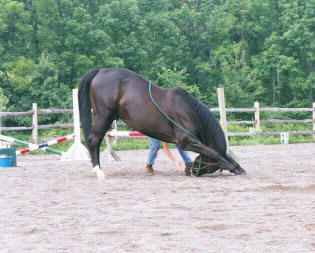
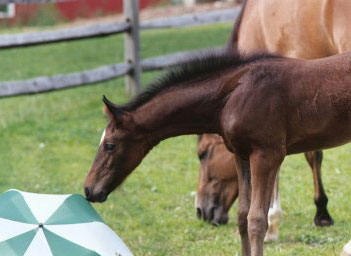
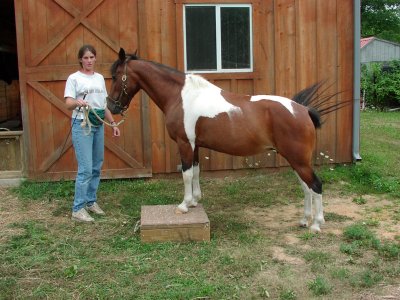
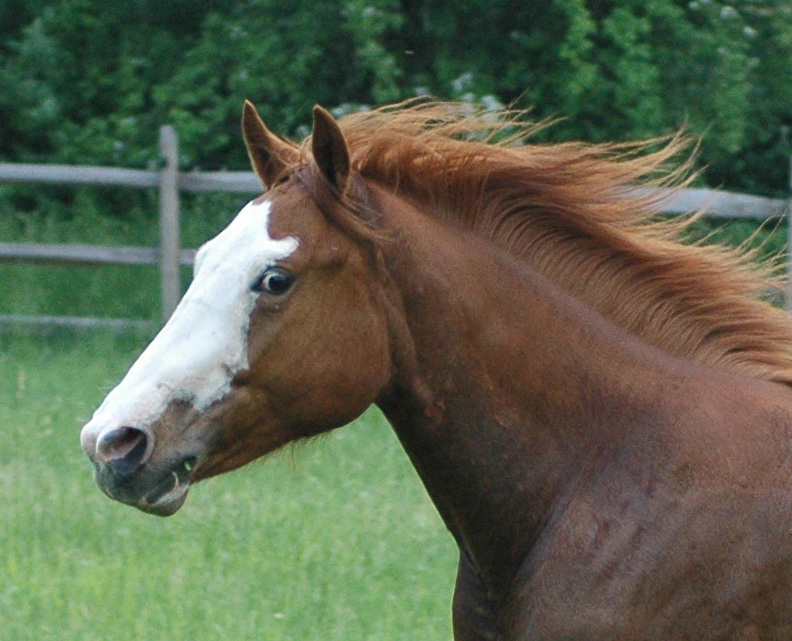
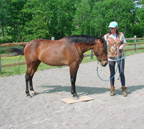
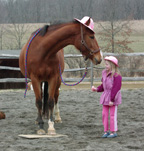
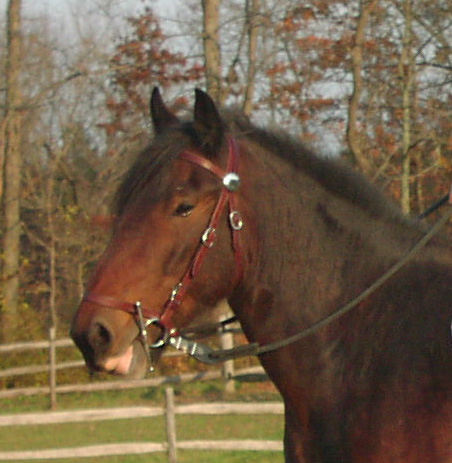
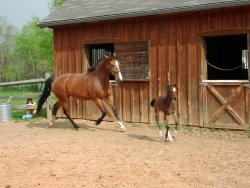 |
|
Food For Thought (2 short articles)
On Babies and Horses...or... the Power of Free Shaping and Creativity
I was sitting in my living room the other day with my youngest daughter just having a quiet moment and thinking about how much fun babies are at her age. She just turned 5 months old and is working really hard on controlling her hands. For those of you who arenít familiar with the developmental stages of babies, they really blossom between 4 and 6 months. They learn to control their heads much better and can start to sit supported on the floor. Even more important, they start to really get control of their hands. They go from wild flailing and just random waving of arms to really concentrating on how to move their hands. Sometimes I catch Geneva just studying her hands very intently. Two weeks ago, if I held up a toy, she would very carefully work her hand (one) over toward the toy, and if she was successful, she would grab it. Now she is starting to do that with both hands at the same time. It takes a lot of concentration and I can see her determination in her face. But, interestingly enough, at this age, she doesn't get frustrated. If she doesn't get it, she either stops trying and does something else or she continues until I help her.
While watching her the other day, I realized that there are a lot of similarities between my fascination with babies and my fascination with clicker training. I love to watch horses think. I love to watch them try to figure things out. I truly believe that if you give them a creative task, they go beyond just working for the carrot and actually start to enjoy the task. This is easy to see with my yearling and the other young horses. But I can also see it with Willy, who is 19 and still loves to try new things. I used to play with the horses a lot in the evening after the kids went to bed and since it was dark, I did a lot of tricks and free shaping in either the aisle or the stall. This space limitation meant we had to be pretty creative about coming up with new things and I did a lot of little games. Sometimes I would just put a new object out and see what they did. The great thing about free shaping is that it is just like watching my baby learn. I can sit back and watch the horse thinking. If I keep the reinforcement rate high enough, the horse will continue to work out the problem. If he or she gets frustrated, I can step in and help or change the game a little. In addition to teaching my horses a lot of new tricks, I learned a lot about the horses as individuals. I now know who is more bold in their offered behaviors and who needs encouragement. I think you can learn a lot from taking the time to just sit and watch a horse work through a puzzle.
Earlier this year, I attended a clicker clinic where we played a game that Alex called the "creativity game." She had gotten the idea from another clicker trainer (Kathy Sdao, I think..) and the idea was to set up a training session where you encouraged the trainee to offer new behaviors. This was done by using the following rules. You could only click a behavior once and you had to click any new behavior. There was some discretion involved if the trainee got into repetitive patterns. So, for example, if the trainee touched an object, click, touched the same one, no click, touched a new one, click and so on. Except if they really got in a rut and just touched everything, you could withhold the click to get them to offer a new behavior. The trainer would start the session with no goal behavior in mind, but just watch the trainee interact with the environment. It was really a chance to see what the trainee might do. We played it with people and it was fascinating. I had expected the trainee to get frustrated at not being clicked for repeating behaviors, but the rate of reinforcement was so high that that frustration never developed. She said later that as long as she was getting clicked, she was ok. I also found it very interesting that the trainee really was driving the game. In our game, the trainee decided that we wanted her to make hot chocolate. Since each step was a different behavior, she was clicked along the way, even though that chain of behaviors was not what we had in mind.
This whole session made me think that we sometimes limit ourselves and what we do with our horses, because we just don't have ideas for things to try. I know that I have periods where I spend a lot of time doing "serious" stuff with my horses and some of this is because I am working through something or getting ready for a clinic. Other times, it is just because I can't think of anything new to do with my horses. So now I feel that it's ok if I don't have a new toy, or a plan. I can still go out and play with the horses and see what they can come up with if I let them do what they want with all my regular stuff. It would be a nice break from our usual training routine where I am directing the training.
I also think that if you don't spend much time free shaping, your horse will be more hesitant to offer behaviors. I can't say this definitively, but I do know that my horses seem to become braver about looking for and offering possible answers when I have spent recent time on free shaping. I love offered behaviors. For me, they are one of the great pluses of clicker training. With some behaviors, I use the horse offering the behavior as both a sign that we are ready to move on and add a level of complication, and also as a way for me to make my job easier. I have been teaching Willy how to do haunches-in from the ground. He found this really confusing as he was willing to move his haunches toward me, but only in the wrong bend. When I asked him to move them toward me while keeping the same bend, he would get confused. We struggled with this for a long time, until I got him to the point where he just knew the right answer was to move his haunches toward me and offered it very freely. Then I could start to adjust him. Before he got to this point, he would back off as soon as I said "well, not quite that." I had to have that piece really solid before I could move on. I had worried that he would consider the bend part of the haunches moving, but he seemed to just learn that stepping his hind end over was the right answer and we could adjust things from there.
In addition to being a nice exercise for the horse, I think free shaping is a great way to introduce novice clicker trainers to clicker training. If you pick a task that has no "wrong" answer, you will find that as the trainer, you don't get trapped into feeling frustrated if your horse is doing something wrong. I always recommend that new clicker trainers just spend some time teaching their horse's simple tricks where it really doesn't matter if the horse gets it or not. You can use it to practice your own timing and problem solving skills and might even teach your horse some fun party tricks to impress visitors.
So, for those of you who haven't done much free shaping, give it a try. You might be surprised at how much fun both you and your horse can have.
Katie, August 15, 2004
You Get What You Click: Looking at the bigger picture.
This was originally posted to clickryder in response to a question about how to decide what to click and what to work on. The person who posed the question had a mare who was a quick learner but also impatient.
Hi Jill,
Home |
Articles |
Clicker Basics |
Community |
FAQ |
Getting Started |
Horse Stories |
Links |
Photos |
Resources
|
||||